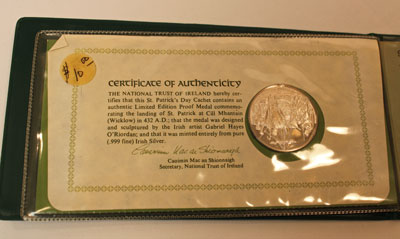Not all small round objects are coins, but they can be valuable just the same – especially if they are made of silver.
Let’s look at an Irish medal that someone purchased years ago and decided to sell.
As noted on the front, this medal from 1972 commemorates St. Patrick’s Day. In particular, the Certificate of Authenticity states:
” The National Trust of Ireland hereby certifies that this St. Patrick’s Day Cachet contains an authentic Limited Edition Proof Medal commemorating the landing of St. Patrick at Cill Mhantáin (Wicklow) in 432 A.D.; that the medal was designed and sculptured by the Irish artist Gabriel Hayes O’Riordan; and that it was minted entirely from pure (.999 fine) Irish silver.
Caoimin Mac an Shionnaigh, Secretary, National Trust of Ireland”
The medal’s obverse shows St. Patrick coming ashore:
The medal’s reverse shows the island of Ireland with its crags and valleys:
The package also includes a description of St. Patrick’s landing:
The text states:
ST. PATRICK’S DAY COMMEMORATIVE MEDAL AND CACHET
The Landing of St. Patrick at Cill Mhantáin – 432 A.D.
This is the first in a series of annual St. Patrick’s Day medallic cachets commemorating important milestones in the life of Ireland’s patron saint. This year’s cachet commemorates St. Patrick’s landing in Ireland at Cill Mhantáin – 432 A.D.
The proof-quality medal in the cachet was designed and sculptured by Gabriel Hayes O’Riordan and was minted of pure Irish silver by the Franklin Mint. This is the first medal that has ever been made of pure (.999 fine) Irish silver. The cachet was postmarked at Cill Mhantáin (Wicklow) on St. Patrick’s Day.
The dies for the medal have now been cancelled and placed in the Maynooth Museum, St. Patrick’s College, County Kildare, which was selected by the National Trust of Ireland as the final repository.
The venerated St. Patrick became known as the national apostle who converted Ireland to Christianity. He was born about 385 in Britain, and was 16 years old when he was captured by Irish pirate raiders, sent to Ireland, and sold as a slave.
One night he received a sign in his sleep that he must escape, which he did by walking almost 200 miles to the coast. There he was able to board a ship for Gaul.
Although he commenced studying for the priesthood, the “voice of the Irish” continued to haunt his thoughts and dreams. Finally, in 432, Patrick set off for Ireland as missionary bishop to evangelize the Irish pagans and to preach the gospel. His faith and toil were richly rewarded, enabling him to carry the gospel into regions no missionary had previously visited.
As you can see above, at some point the silver medal and cachet sold for $10.00. Without weighing, the silver medal’s troy ounce weight is not clear. It’s roughly the size of our modern silver dollars, but it could be slightly smaller and have less thickness. Our commemorative silver dollars contain roughly .77 troy ounce of silver mixed with copper. This medal “minted entirely from pure Irish silver” may contain the full troy ounce.
Regardless of exact weight, at today’s silver rate of over $39 per ounce, this medal is certainly worth more than the $10.00 price tag.




